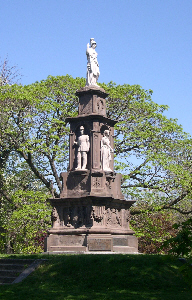
This some what weather worn monument was constructed in 1870 to commemorate the loss of nine young men from Toronto (three of whom were U of T students) who were killed defending Canada in one of the lesser know episodes of our history. The Fenian Raids accomplished little, but they did spur action towards Confederation. A memorial window in the lost students’ memory is located in the East Hall of University College. See below.
The Fenian Brotherhood was an Irish nationalist organization which aimed to free Ireland from British rule. The name came from Fiann, the legendary defenders of Ireland in the time of Finn. A major objective was to raise money for a rising in Ireland; however as many Irish sympathisers had received military training and experience in the Union army during the American Civil War, a secondary objective developed of capturing Canada to use as a hostage to force Britain to grant independence to Ireland. Between 1866 and 1871 this group raided Canadian territory from New Brunswick to Manitoba.
Early in the morning of June 1,1866, about 900 Fenians crossed the Niagara River, presumably to capture or destroy the Welland Cannel. They occupied Fort Erie. The main force headed west towards Port Colbourne and the Cannel, stopping near the village of Ridgeway at Lime Ridge where the terrain would provide some cover from the approaching British forces. A smaller force of Canadian volunteers met the invaders here.

Window in Upper East Hall. University College in memory of students lost at the Battle of Ridgeway.
It would be nice to say that the Battle of Ridgeway was a Canadian victory. Unfortunately this just was not true. The small force of “weekend warriors” were no match for battle hardened Civil War veterans in a superior position and were quickly routed. Nevertheless, the invaders had not expected citizen resistance. They expected that the Canadians would welcome them as friends come to free them from British rule. As a result, the Fenians had second thoughts and quickly retired across the border before the approaching larger Canadian force with British Regular Soldiers could contact them. This was the only Fenian victory of the hostilities. One group invaded Quebec, but meeting no opposition contented themselves with looting undefended farms of some chickens, pigs, and liquor. In all other cases when they met British forces they were repulsed. Eventually the Americans disarmed these bands as they should have in the beginning and the danger passed. Irish Nationalists continued to get funding from friends in the States, but restricted action to the British Isles.
While the most results of these raids were minimal, they did give an stimulus to those contemplating Confederation. The Canadian provinces joined under a new concept that of a Dominion. This concept was later applied to other British territories such as Australia, New Zealand and Newfoundland who wished greater autonomy. It was also used as a stepping stone to independence of other territories such as India, Israel and Ireland. Each of whom were granted Dominion status, with a modified “BNA Act” and a Governor General, before they became fully independent. Thus in a small and roundabout way the raids did contribute to Irish independence.
